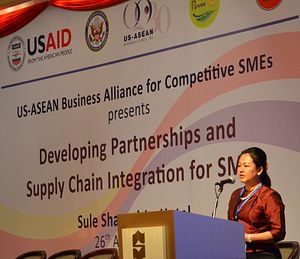The United States is mulling the development of a new facility based in Asia to coordinate and market U.S. infrastructure to the region in the face of growing competition by China and other countries, a U.S. official said Tuesday.
The facility, which is still in the works, would serve as a “one-stop shop” for various U.S. actors to better coordinate and market their activities to Asian nations and other relevant regional institutions, James Carouso, Director of Maritime Southeast Asia Affairs at the U.S. State Department, told a roundtable at the Stimson Center, a Washington, D.C.-based think tank.
The news comes in the wake of growing demand for infrastructure in Asia as well as new efforts by regional actors to fill it. According to KPMG, the ten countries of the Association of Southeast Asian Nations (ASEAN) alone will need around $60 billion per year until 2022 to fulfill their infrastructure needs. China has been keen to step in, most recently with its Asian Infrastructure Investment Bank (See: “The Truth About China’s Big, Bad Infrastructure Bank”). Japan has also recently unveiled its own proposal to inject $110 billion to develop high-quality Asian infrastructure (See: “Is This Japan’s New Challenge to China’s Infrastructure Bank?”).
U.S. companies currently occupy about 13% of the infrastructure market in Southeast Asia, Carouso said. But while regional governments and companies do find individual products from different U.S. actors appealing, they are frustrated that the United States does not market them as a ready-made package unlike their competitors from China or Japan. With regional competitors putting together such packages – sometimes even before request for proposals (RFPs) go out on individual projects – the United States has often found it difficult to compete, Carouso said.
Washington cannot simply replicate the practices of China and its state-owned enterprises or Japan and its companies – the relationship between business and government in the United States is quite different. But a “one-stop shop” facility, Carouso said, would help “organize resources” between various U.S. actors in the infrastructure space – including the U.S. Treasury Department, the Export-Import Bank and the U.S. Agency for International Development (USAID). That would help make things easier for regional governments and other actors like the Asian Development Bank to work with the United States.
Aside from the facility, Carouso also said that other actors can do more to help the United States market itself in order to overcome the challenges from regional players. He pointed to a groundbreaking report released in 2013 by the USAID and the U.S. Chamber of Commerce that showed that based on data from 2004 to 2012, the United States was actually the largest investor in Indonesia during the period, instead of the fourth largest investor as most sources had indicated. He also said that companies themselves could be much bolder about advertising their corporate social responsibility (CSR) initiatives in the region to demonstrate the value of U.S. companies relative to their rivals.
In spite of these efforts, Carouso admitted that the way that the United States conducted business meant that there were limitations to what it could do to compete with initiatives by other regional players, whether it be $110 billion dollar Japanese infrastructure proposals or a series of large billion dollar deals inked by large delegations of CEOs and officials during Chinese visits to Southeast Asia. Even if some or most of these Chinese investments are not ultimately realized and come with significant risks, the figures themselves would still seem quite big to the untrained eye (See: “Is China’s Economic Power in ASEAN Overblown?” and “China and Indonesia Under ASEAN: Show Me The Money”).
“They are still big numbers,” he said.

































